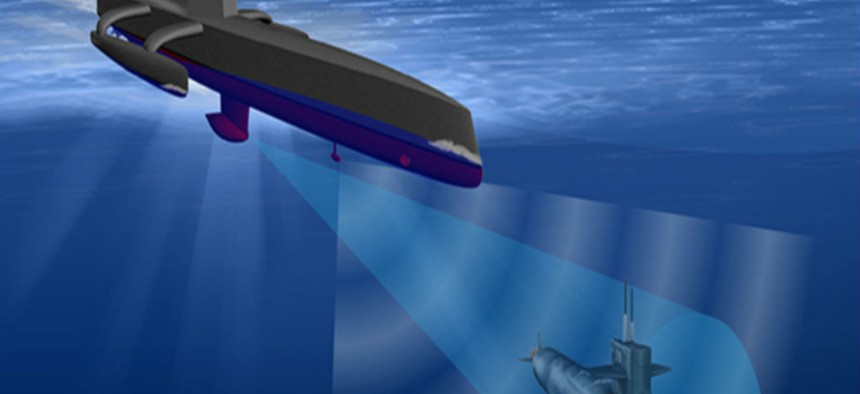DARPA advances testing for sub-hunting surface drone
DARPA has awarded an $8.5 million contract extension to Leidos for continued test phase development of the Anti-Submarine Warfare Continuous Trail Unmanned Vessel sea-drone program.
The Pentagon’s research arm is extending testing of its sub-hunting drone that is able to travel autonomously for up to 90 days and uses sensors and sonar technology to search for enemy submarines and other airborne and undersea threats.
The Defense Advanced Research Project Agency (DARPA) has awarded an $8.5 million contract extension to Reston, Virginia-based Leidos for continued test phase development of the Anti-Submarine Warfare Continuous Trail Unmanned Vessel, or ACTUV program.
The 132-foot drone uses advanced hydro-acoustics, pattern recognition and algorithms for unmanned navigation to locate and shadow diesel-electric enemy submarines. The idea is to track them, if necessary, over a period of months so they are compelled to stay away from strategically vital areas.
Testing of the sea drone is designed to demonstrate the capability of the ACTUV system to employ non-conventional sensor technologies that achieve robust continuous tracking of the quietest submarine targets, DARPA ACTUV program manager Scott Littlefield said.
DARPA officials also say the objective of the ACTUV is to generate a vessel design that exceeds state-of-the art platform performance to provide propulsive overmatch against diesel-electric submarines at a fraction of their size and cost.
Picking up the quiet hum of a battery-powered, diesel-electric submarine in busy coastal waters is “like trying to identify the sound of a single car engine in the din of a major city,” Rear Adm. Frank Drennan, commander of the Naval Mine and Anti-Submarine Warfare Command, said in a statement.
The ACTUV’s use of sonar is also designed to limit risks to the marine ecosystems and undersea life such as whales.
The submarine-hunting drone ship was christened this past April and, according to a recent story in Defense Systems, recently tested its first payload. (Defense Systems Story HERE)
“The first payload deployed by the unmanned ASW (anti-submarine warfare) ship was its Towed Airborne Lift of Naval Systems (TALONS) sensor suite, which carries intelligence, surveillance and reconnaissance (ISR) sensors up to altitudes ranging from 150 to 1,500 feet,” said the article.
Using an airborne platform can further expand the mission set of the drone ship by integrating additional surface and air-oriented ISR assets.
The Pentagon’s Strategic Capabilities Office, DARPA and the Office of Naval Research have been emphasizing the development of Unmanned Surface Vehicles, or USVs and hope that this emerging technology could substantially change amphibious operations and naval maritime tactics. The plan is to limit risk to people by using drone-ships to perform essential missions such as forward-locating sensors, delivering equipment and supplies, launching swarming small boat attacks and further dispersing the fleet.
NEXT STORY: Navy deal upgrades radar algorithms




